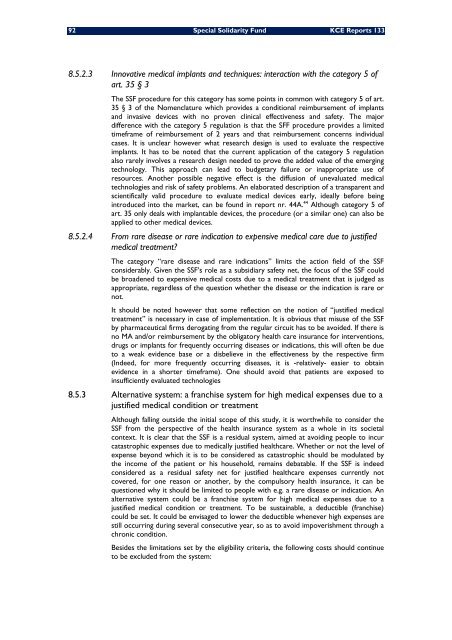Optimalisatie van de werkingsprocessen van het Bijzonder ... - KCE
Optimalisatie van de werkingsprocessen van het Bijzonder ... - KCE
Optimalisatie van de werkingsprocessen van het Bijzonder ... - KCE
Create successful ePaper yourself
Turn your PDF publications into a flip-book with our unique Google optimized e-Paper software.
92 Special Solidarity Fund <strong>KCE</strong> Reports 133<br />
8.5.2.3 Innovative medical implants and techniques: interaction with the category 5 of<br />
art. 35 § 3<br />
The SSF procedure for this category has some points in common with category 5 of art.<br />
35 § 3 of the Nomenclature which provi<strong>de</strong>s a conditional reimbursement of implants<br />
and invasive <strong>de</strong>vices with no proven clinical effectiveness and safety. The major<br />
difference with the category 5 regulation is that the SFF procedure provi<strong>de</strong>s a limited<br />
timeframe of reimbursement of 2 years and that reimbursement concerns individual<br />
cases. It is unclear however what research <strong>de</strong>sign is used to evaluate the respective<br />
implants. It has to be noted that the current application of the category 5 regulation<br />
also rarely involves a research <strong>de</strong>sign nee<strong>de</strong>d to prove the ad<strong>de</strong>d value of the emerging<br />
technology. This approach can lead to budgetary failure or inappropriate use of<br />
resources. Another possible negative effect is the diffusion of unevaluated medical<br />
technologies and risk of safety problems. An elaborated <strong>de</strong>scription of a transparent and<br />
scientifically valid procedure to evaluate medical <strong>de</strong>vices early, i<strong>de</strong>ally before being<br />
introduced into the market, can be found in report nr. 44A. 44 Although category 5 of<br />
art. 35 only <strong>de</strong>als with implantable <strong>de</strong>vices, the procedure (or a similar one) can also be<br />
applied to other medical <strong>de</strong>vices.<br />
8.5.2.4 From rare disease or rare indication to expensive medical care due to justified<br />
medical treatment?<br />
The category “rare disease and rare indications” limits the action field of the SSF<br />
consi<strong>de</strong>rably. Given the SSF’s role as a subsidiary safety net, the focus of the SSF could<br />
be broa<strong>de</strong>ned to expensive medical costs due to a medical treatment that is judged as<br />
appropriate, regardless of the question w<strong>het</strong>her the disease or the indication is rare or<br />
not.<br />
It should be noted however that some reflection on the notion of “justified medical<br />
treatment” is necessary in case of implementation. It is obvious that misuse of the SSF<br />
by pharmaceutical firms <strong>de</strong>rogating from the regular circuit has to be avoi<strong>de</strong>d. If there is<br />
no MA and/or reimbursement by the obligatory health care insurance for interventions,<br />
drugs or implants for frequently occurring diseases or indications, this will often be due<br />
to a weak evi<strong>de</strong>nce base or a disbelieve in the effectiveness by the respective firm<br />
(In<strong>de</strong>ed, for more frequently occurring diseases, it is -relatively- easier to obtain<br />
evi<strong>de</strong>nce in a shorter timeframe). One should avoid that patients are exposed to<br />
insufficiently evaluated technologies<br />
8.5.3 Alternative system: a franchise system for high medical expenses due to a<br />
justified medical condition or treatment<br />
Although falling outsi<strong>de</strong> the initial scope of this study, it is worthwhile to consi<strong>de</strong>r the<br />
SSF from the perspective of the health insurance system as a whole in its societal<br />
context. It is clear that the SSF is a residual system, aimed at avoiding people to incur<br />
catastrophic expenses due to medically justified healthcare. W<strong>het</strong>her or not the level of<br />
expense beyond which it is to be consi<strong>de</strong>red as catastrophic should be modulated by<br />
the income of the patient or his household, remains <strong>de</strong>batable. If the SSF is in<strong>de</strong>ed<br />
consi<strong>de</strong>red as a residual safety net for justified healthcare expenses currently not<br />
covered, for one reason or another, by the compulsory health insurance, it can be<br />
questioned why it should be limited to people with e.g. a rare disease or indication. An<br />
alternative system could be a franchise system for high medical expenses due to a<br />
justified medical condition or treatment. To be sustainable, a <strong>de</strong>ductible (franchise)<br />
could be set. It could be envisaged to lower the <strong>de</strong>ductible whenever high expenses are<br />
still occurring during several consecutive year, so as to avoid impoverishment through a<br />
chronic condition.<br />
Besi<strong>de</strong>s the limitations set by the eligibility criteria, the following costs should continue<br />
to be exclu<strong>de</strong>d from the system:

















